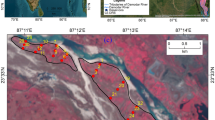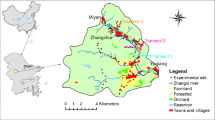Abstract
Mining activities pose a potential risk of metal contamination around mining sites. On May 6, 2010, a tailings dam failure of the Mazraeh copper mine near Ahar in East Azerbaijan province, Iran, released vast amounts of mine wastes. To better understand the magnitude of copper contamination in the waste-affected soils, it is important to assess the spatial distribution of soil copper content at unsampled points. A total of 30 soil samples and their surficial sediments together with the 6 uncontaminated control samples (0–10 and 10–30 cm) were collected along the stream flow that joined Ahar-Chai River. Some of soil properties as well as total copper concentration were determined in all samples. The mean value of the latter in the surface contaminated soils was found to be approximately two times more than controls. Furthermore, the mean concentration of copper in the surface loaded material was 10 times more than the soils. High copper concentrations were observed in surficial sediments of the soils near the broken tailings dam. The Inverse Distance Weighting (IDW) method was employed in data analysis. The spherical and Gaussian semivariogram models were properly fitted to the data of copper contents in soils and surficial sediments.




Similar content being viewed by others
Abbreviations
- IDW:
-
Inverse Distance Weighting
- GPS:
-
Global Positioning System
- EC:
-
Electrical conductivity
- CEC:
-
Cation exchange capacity
- OC:
-
Organic carbon
- CCE:
-
Calcium carbonate equivalent
- CF:
-
Contamination factor
- SCC:
-
Soil copper concentration
- CCS:
-
Copper concentration of surficial sediments
- C 0 :
-
Nugget
- C 0+C :
-
Sill
- A0 :
-
Range of parameter
- RSS:
-
Residual sum of squares
- DSM:
-
Digital soil mapping
- CV:
-
Coefficient of variation
- UTM:
-
Universal Transfer Mercator
References
Adriano DC (2001) Trace elements in terrestrial environments: biogeochemistry, bioavailability, and risk of metals, 2nd edn. Springer-Verlag, New York
Cambardella CA, Moorman TB, Parkin DL, Karlen JM, Novak R, Turco F, Konopka AE (1994) Field-scale variability of soil properties in central Iowa soils. SSSAJ 58:1501–1511
Chapman HD (1965) Cation exchange capacity. In: Black CA et al. Methods of soil analysis, 2nd edn. Part 2, SSSA, Madison, WI, pp 891–901
Chen M, Ma L (2001) Comparison of three aqua regia digestion methods for twenty Florida soils. SSSAJ 65:499–510
Elliot P, Wakefield J, Best NJ, Briggs D (2000) Spatial epidemiology methods and applications, Oxford University Press
Gallant JC, Dowling TD (2003) A multi-resolution index of valley bottom flatness for mapping depositional areas. Water Resour Res 39:1347–1360
Gee GW, Bauder HW (1986) Physical and mineralogical methods. In: Page AL (ed) Methods of soil analysis, 2nd edn. Part 1, SSSA, Madison,WI, pp 383–411
Goovaerts P (1999) Geostatistics in soil science: state-of-the-art and perspectives. Geoderma 89:1–45
Gotway CA, Ferguson RB, Hergert GW, Peterson TA (1996) Comparison of kriging and inverse distance methods for mapping soil parameters. SSSAJ 60:1237–1247
Grzebisz W, Ciesla L, Diatta JB (2001) Spatial distribution of copper in arable soils and in non-consumable crops (flax, oil-seed rape) cultivated near a copper smelter. Polish J Environ Stud 10:269–273
Hakanson L (1980) An ecological risk index for aquatic pollution control: a sedimentological approach. Water Res 14:975–1001
Henderson BL, Webster R, Mckenzie NJ (2008) Statistical analysis. In: McKenzie NJ, Grundy MJ, Webster R, Ringrose-Voase AJ (eds) Guidelines for surveying soil and land resources. CSIRO press, Australia, pp 327–348
Hooker PJ, Nathanial CP (2006) Risk-based characterization of lead in urban soils. Chem Geol 226:340–351
Hutton M, Meeus C (2001) Analysis and conclusions from member states assessment of the risk to health and the environment from cadmium in fertilizers. Final report, European Commission-Enter-Prise DG; 1–134
Jafarnejadi AR, Saadinejad S, Gholami A (2013) Spatial variation of copper in soils and grains of wheat farms in southern Iran. Caspian J Appl Sci Res 2:35–41
Jahanshahi R, Zare M, Schneider M (2014) A metal sorption/desorption study to assess the potential efficiency of a tailings dam at the Golgohar iron ore mine, Iran. Mine Water Environ 33:228–240
Joshua OO, Evelyn OO, Luis CT, Azubuike CO, Donald MJ (2014) Assessment of spatial distribution of selected soil properties using geospatial statistical tools. Commun Soil Sci and Plant Anal 45:2182–2200
Kabata-Pendias A (2011) Trace elements in soils and plants, 4rd edn. CRC Press, Boca Raton
Kalbitz K, Wennrich R (1998) Mobilization of heavy metals and arsenic in polluted wetland soils and its dependence on dissolved organic matter. Sci Total Environ 209:27–39
Khorasanipour M, Eslami A (2014) Hydro-geochemistry and contamination of trace elements in cu-porphyry mine tailings: a case study from the Sarcheshmeh mine, SE Iran. Mine Water Environ 33:335–352
Kravchenko A, Bullock DG (1999) A comparative study of interpolation methods for mapping soil properties. SSSAJ 91:391–400
Lark RM, Ferguson RB (2004) Mapping risk of soil nutrient deficiency or excess by disjunctive and indicator kriging. Geoderma 118:39–53
Leenaers H, Okx JP, Burrough PA (1990) Comparison of spatial prediction methods for mapping floodplain soil pollution. Catena 17:535–550
Lu JY, Wong DW (2008) An adaptive inverse-distance weighting spatial interpolation technique. Comput Geosci 34:1044–1055
McKenzie NJ, Ryan PJ (1999) Spatial prediction of soil properties using environmental correlation. Geoderma 89:67–94
Nelson DW, Sommers LE (1982) Total carbon and organic matter. Methods of Soil Analysis, SSSA, Madison
Pandey AK, Pandey SD, Misra V (2000) Stability constants of metal–humic acid complexes and its role in environmental detoxification. Ecotoxicol Environ Safe 47:195–200
Rhoades JD (1996) Salinity: electrical conductivity and total dissolved solids. In: Sparks DL (ed) Methods of soil analysis. 3rd edn. Part 3, SSSA, Madison,WI, pp 417–435
Rinkelbe J, Shaheen SM (2015) Miscellaneous additives can enhance plant uptake and affect geochemical fractions of copper in a heavily polluted riparian grassland soil. Ecotoxicol Environ Safe 119:58–65
Rodríguez-Tovar FJ, Martín-Peinado FJ (2014) Lateral and vertical variations in contaminated sediments from the Tinto River area (Huelva, SW Spain): incidence on trace maker activity and implications of the palaeontological approach. Palaeogeo, Palaeocli, Palaeoeco 414:426–437
Romkens PFAM, Salomons W (1998) Cd, Cu and Zn solubility in arable and forest soils: consequences of land use changes for metal mobility and risk assessment. Soil Sci 163:859–871
Salomons W (1992) Environmental impact of metals derived from mining activities processes, predictions, and prevention. J Geochem Explor 52:5–23
Schloeder CA, Zimmermann NE, Jacobs MJ (2001) Comparison of methods for interpolating soil properties using limited data. SSSAJ 65:470–479
Shahbazi F, De la Rosa D (2010) Towards a new agriculture for the climate change era in West Asia, Iran. In: Simard SW, Austin ME (eds) Climate change and variability. SCIYO Publications, Croatia, pp 337–364
Shahbazi F, Aliasgharzad N, Ebrahimzad SA, Najafi N (2013) Geostatistical analysis for predicting soil biological maps under different scenarios of land use. Eur J Soil Bio 55:20–27
Silva VR, Reichert JM, Storck L, Feijo S (2003) Spatial variability of chemical soil properties and corn yield on a sandy loam. Revista Brasileira de Ciência de Solo 27:1013–1020 (in Spanish)
Sun H, Juan L, Xiaojun M (2014) Heavy metals’ spatial distribution characteristics in a copper mining area of Zhejiang province. J Geog Info Sys 4:46–54
Thomas GW (1996) Soil pH and soil acidity. In: Sparks DL (ed) Methods of soil analysis. 3rdedn. Part 3, SSSA, Madison,WI, pp 475–490
Tipper JC (2008) A simple method for representing some univariate frequency distributions, with particular application in Monte Carlo-based simulation. Comput Geosci 34:1154–1166
USDA-NRCS (2004) Soil survey laboratory methods manual, Soil survey investigations report, No. 4, , Version 4, Washington, DC
Usman A (2008) The relative sorption selectivity’s of Pb, Cu, Zn, Cd and Ni by soils developed on shale in New Valley, Egypt. Geoderma 144:334–343
Veinott G, Sylvester P, Hamoutene D, Anderson MR, Meade J, Payne J (2003) State of the marine environment at Little Bay Arm, Newfoundland and Labrador, Canada, 10 years after a “do nothing” response to a mine tailings spill. J Environ Monit 5:626–634
Vrhovnik P, Dolenec T, Serafimovski T, Dolenec M, Smuc NR (2013) The occurrence of heavy metals and metalloids in surficial lake sediments before and after a tailings dam failure. Polish J Environ Stud 22:1525–1538
Wälder K, Wälder O, Rinkelbe J, Menz J (2008) Estimation of soil properties with geostatistical methods in floodplains. Arch Agron Soil Sci 54:275–295
Webster R (2001) Statistics to support soil research and their presentation. Eur J of Soil Sci 52:331–340
Webster R (2008) Geostatistics. In: McKenzie NJ, Grundy MJ, Webster R, Ringrose-Voase AJ (eds) Guidelines for surveying soil and land resources. CSIRO press, Australia, pp 369–382
Whelan BM, McBratney AB, Rossel RAV (1996) Spatial prediction for precision agriculture. In: Proceedings of the 3rd International Conference on Precision Agriculture, ASA/CSSA/SSSA, WI, USA
Wu F, Liu YL, Xia Y, Shen ZG, Chen YH (2011) Copper contamination of soils and vegetables in the vicinity of Jiuhuashan copper mine, China. Environ Earth Sci 64:761–769
Zhou JM, Dang Z, Cai MF, Liu CQ (2007) Soil heavy metal pollution around the Dabaoshan mine, Guangdong province, China. Pedosphere 17:588–594
Author information
Authors and Affiliations
Corresponding author
Additional information
This article is part of the Topical Collection on Water Resource Management for Sustainable Development
Rights and permissions
About this article
Cite this article
Khamseh, A., Shahbazi, F., Oustan, S. et al. Impact of tailings dam failure on spatial features of copper contamination (Mazraeh mine area, Iran). Arab J Geosci 10, 244 (2017). https://doi.org/10.1007/s12517-017-3040-y
Received:
Accepted:
Published:
DOI: https://doi.org/10.1007/s12517-017-3040-y




